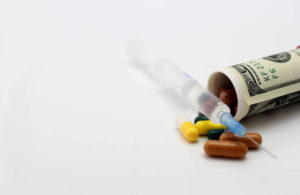
Image from https://torange.biz/medications-big-money-19928
The pharma sector saw robust revenues across several key therapeutic areas in the second quarter of 2023, with oncology, immunology, and infectious diseases leading the pack. Merck’s blockbuster cancer drug Keytruda maintained its oncology dominance with sales topping $6 billion, while AbbVie’s Humira regained its crown as the world’s best-selling drug despite new competition. Gilead’s HIV regimen Biktarvy and Merck’s human papillomavirus vaccine Gardasil also posted strong growth. Additionally, neurology emerged as an area of expansion for companies like Roche, AbbVie and Biogen.
Our breakdown of 2023 pharma revenue by product categories, based on an analysis of Q2 data from 15 Big Pharma companies, reveals that oncology led the way with revenues surpassing $52 billion. Following closely was immunology with over $23 billion in revenues. Infectious diseases, cardiovascular, and neurology also showcased impressive figures, with revenues of approximately $15.5 billion, $10.5 billion, and $6.8 billion respectively.
Oncology
In the second quarter of 2023, the oncology sector stood out as a top revenue driver for several pharma firms. AstraZeneca led the charge with a $26,742 million in sales, with major contributors being Tagrisso ($1,491 million), Imfinzi ($1,076 million), and Lynparza ($717 million). Merck & Co. also made a significant mark with its blockbuster drug Keytruda, which garnered sales of $6.271 billion.
Merck’s flagship oncology drug, Keytruda, saw its sales spike 21% in the second quarter thanks in part to its use in the treatment of earlier-stage cancers. In addition, the drug’s continued strong demand in metastatic indications reinforces its leadership position in oncology.
In Q2, Tagrisso revenues were up 10%. The drug, however, will see headwinds later this year, including a mandatory price reduction in Japan. In the positive column, the company highlighted that upbeat data from the Tagrisso ADAURA trial. In the study, whose results were shared at the 2023 American Society of Clinical Oncology (ASCO) Annual Meeting, adjuvant treatment with osimertinib (Tagrisso) boosted survival rates in patients with resected EGFR-mutated non-small cell lung cancer (NSCLC) stages IB to IIIA. Patients who received the drug had an 88% survival rate five years post-surgery, in contrast to the 78% rate for those who got placebo, equating to a 51% reduced risk of death for those on osimertinib.
Immunology
The immunology sector continued its impressive performance in Q2 2023. AbbVie’s Humira, with sales of $7.553 billion, continued to dominate the market. The company is, however, beginning to see Humira biosimilar competition in the U.S. market. To deal with the revenue challenge, the company is executing a long-term diversification growth strategy. In its earnings call, CEO Richard Gonzalez noted that he was “extremely pleased with the progress” of the initiative.
Another significant contributor from AbbVie was Skyrizi, which generated $3.243 billion. The drug, also known as risankizumab-rzaa, is an interleukin-23 (IL-23) inhibitor with FDA approval for plaque psoriasis, psoriatic arthritis, and Crohn’s disease. It works by binding to excess IL-23, a cytokine associated with various chronic immune-mediated diseases. It is the only IL-23 drug to win approval for Crohn’s. The company is optimistic about its potential to win an FDA nod for ulcerative colitis as well based on recent Phase 3 data.
Sanofi’s Dupixent also made a notable contribution with $2.766 billion in sales.
Infectious Diseases
The infectious diseases category saw robust contributions from several companies. Merck & Co.’s Gardasil / Gardasil 9 topped the charts with a revenue of $2.458 billion. Another notable mention is Gilead’s Biktarvy, which brought in $2.100 billion. Pfizer’s infectious disease portfolio, led by drugs like Biktarvy, contributed $3.483 billion to the total revenue.
Gardasil saw 53% growth in the second quarter with global demand — especially from China — contributing. The country’s expanded indication of Gardasil 9 for girls and women aged nine to 45 helped bolster its sales. Merck, however, notes that the growth rate in the latter half of the year could taper.
Neurology
In the neurology sector, Roche’s Ocrevus led the pack with impressive sales of $1.638 billion. AbbVie also showcased strong performance with Botox Therapeutic and Vraylar, generating $1.467 billion and $1.219 billion, respectively. AbbVie has seen strong growth in its neuroscience division. “Based on the current run rate, this portfolio is now on pace to add more than $1 billion of incremental revenue this year. with continued strong growth from Vraylar as well as our leading migraine portfolio,” said CEO Gonzalez in its Q2 earnings call.
One of the factors driving the growth of Vraylar (cariprazine) is its growing use for major depressive disorder, an indication it received FDA approval for in late 2022. The drug has also shown recent promise for anhedonia — a stubborn MDD symptom — in a small study.
Respiratory
The respiratory category, while having fewer blockbuster performers, still showcased significant revenues. GSK’s respiratory products stood out, generating $1.792 billion. AstraZeneca’s Symbicort also made a significant contribution, raking in $0.600 billion in sales. The company, however, anticipates generic competition in the U.S. later in 2023.